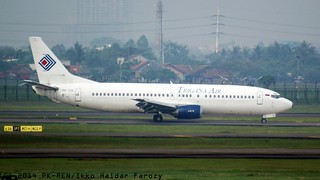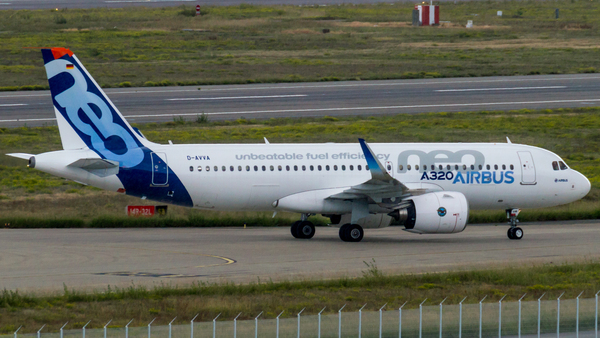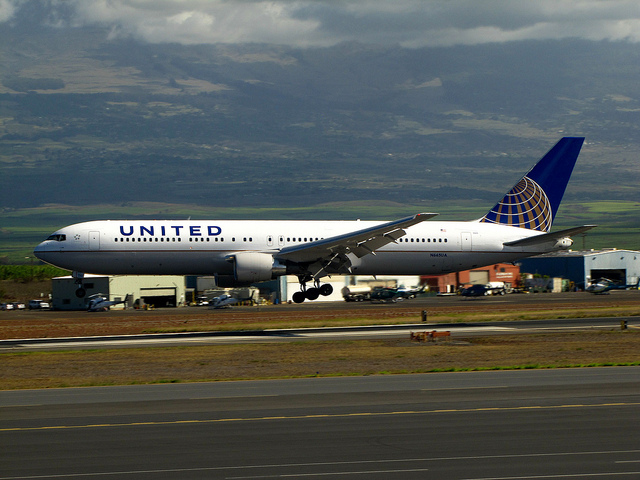Trigana B733 at Wamena on Sep 13th 2016, hard landing results in main gear collapse
Last Update: August 3, 2020 / 22:31:46 GMT/Zulu time
Incident Facts
Date of incident
Sep 13, 2016
Classification
Accident
Cause
Hard landing
Airline
Trigana Air Service
Flight number
IL-7321
Departure
Jayapura, Indonesia
Destination
Wamena, Indonesia
Aircraft Registration
PK-YSY
Aircraft Type
Boeing 737-300
ICAO Type Designator
B733
A ground observer reported, the cloud base was about 150-200 feet, the aerodrome features no instrument approaches and thus is strictly visual approach only. A Trigana Boeing 737-300 landed successfully a few minutes earlier, then PK-YSY was seen breaking out of cloud, correcting to the right and pitching down to descend towards the runway. The aircraft subsequently touched down very hard in a nose high attitude, the left main gear separated from the airframe, the right main gear collapsed, and the aircraft skidded on nose gear, both engines and the belly to a halt right of the right hand edge of the runway past the new apron. The airport is currently closed.
Indonesia's Ministry of Transport reported flight TGN-7321/IL-7321, carrying 15,353 kg of freight consisting of drums of Diesel as well as sugar, rice and other goods, was involved in an accident at Wamena at 07:35L, when the aircraft slid to a halt at the right hand side of the runway. There were no injuries. The condition of the runway surface is being assessed, the accident is being investigated by Indonesia's NTSC/KNKT.
On Dec 8th 2016 the NTSC released their preliminary report reporting the aircraft impacted the runway producing a vertical acceleration of +3.25G causing the left main gear to collapse and separate and the right main gear to collapse, the aircraft received substantial damage.
The NTSC reported that the flight was conducted in visual meteorologic conditions, enroute at FL180 the flight crew was able to identify another Trigana flight heading for Wamena. The aircraft was number three in landing sequence and entered a hold before being cleared for the approach.
At about 7000 feet the crew received landing clearance however could not identify visual checkpoint Mount Pikei and decided to check another visual reference, a church at the right base runway 15. The captain (59, ATPL, 23,823 hours total, 9,627 hours on type) decided to reduce the rate of descent. The first officer (22, CPL, 650 hours total, 480 hours on type) reported that the runway was not in sight and called for a go-around. At 5700 feet MSL and about 2nm from the runway threshold the crew acquired visual reference with the runway and increased the rate of descent, that ultimately led to a "touch down" at +3.25G. The aircraft came to a stop about 1890meters past the runway threshold.
The weather office reported the weather at the time was defined by haze, visibility was 2000 meters.
On Aug 4th 2020 the KNKT released their final report concluding the probable cause of the accident was:
Refer to the previous aircraft that was landed safely, the pilot confidence that a safe landing could be made and disregarding several conditions required for go around.
The KNKT analysed:
The Flight Data Recorder (FDR) data showed that during approach the aircraft descend with rate of about 1,500 feet/minute and at altitude about 6,200 feet or at about 1,000 feet above ground level (AGL), the altitude was maintained for about 18 seconds. Thereafter, the aircraft descend with average rate of about 900 feet/minute. The Cockpit Voice Recorder (CVR) data showed that after the GPWS altitude callout ‘one thousand’ the PF able to see the church, however the pilot had not seen the runway.
The pilot decision to maintain the altitude likely due to the weather condition that made the pilot did not have visual references. After the pilot saw the church, the descend approach continued.
The approach descend once again was stopped, and the aircraft maintained at about 5,600 feet or about 400 feet AGL for about 21 seconds. The CVR data showed that after the EGPWS altitude callout ‘five hundred’, the PF instructed the PM to check the runway. This showed that up to this point, the pilot had not seen the runway. The PM replied that they were one mile away which probably refer to the runway threshold and advised for go around and also mentioned that they were too far. The stop descend might had made the aircraft deviated from the approach profile and became above the correct glide path.
At 22:30:41 UTC, the CVR recorded EGPWS warning SINK RATE which indicates that the aircraft was on excessive descent rate. The FDR showed the attitude recorded pitch down to 11°, the calculated rate of descend reached up to 3,200 feet/minute, the aircraft rolled to the right up to 28° and the speed increased by 7 knots. The video footage showed the aircraft attitude was rolling and pitching down. The CVR recorded EGPWS warning ‘PULL UP’. During this time, the PM reported to the tower controller, that the runway was in sight. Five seconds after the EGPWS warning ‘SINK RATE’ the aircraft touched down.
The rate of descend was recorded up to 3,200 feet/minute while normal approach landing rate of descend for approach was between 700 to 800 feet/minute. This excessive rate of descend indicated that when the pilot able to see the runway, the aircraft was too high for approach and require excessive sink rate to reach the touch down point.
The aircraft touched down with vertical acceleration 3.25 g, the aircraft speed 137 knots, pitch 7° up and roll to the left 5°. The calculation of FDR data showed that the rate of descend prior to touch down was 2,300 feet/minute.
The CVR recorded the pilot statement of the power levers were advanced but the power did not increase. The advancing power levers might be the pilot attempt to reduce the rate of descend by pitch up and advanced power. The aircraft pitch changed from 11° down to 7° up reduced the rate of descend from 3,200 feet/minute to 2,300 feet/minute on touchdown. The CASR Part 25.473 requires the landing gear able to support a landing with the rate of descend 10 feet/second (600 feet/minute). The aircraft landed with the rate of descend of 2,300 feet/minute was greater than the requirement.
The pilot stated that the power levers were advanced to recover the sink rate but the engine power did not increase, this might be caused by the delay of the engine to accelerate. The FDR did not record the engine parameters therefore, the throttle movement and the change of power could not be determined. These pilot actions indicated that the recovery to the condition was not in timely manner.
The aircraft touched down with recorded vertical acceleration was 3.25 g and roll 5° to the left. The impact force was received mainly by the left main landing gear. The excessive vertical acceleration created significant force to the left main landing gear combined with the side force which not aligned with the normal landing direction resulted in the collapse of the left main landing gear.
Excessive sink rate resulted in touched down with high vertical acceleration and led to the failure of the main landing gears.
The instrument approach procedure was not available for Wamena Airport and the approach and landing shall be performed under Visual Flight Rules (VFR). The visual navigation aids such as Visual Approach Slope Indicator (VASI) and several runway lights were unserviceable at the time of occurrence.
According to the CASR Part 91, the weather minima for approach in VFR was
visibility of 4.8 km and ceiling 1,000 feet.
During the flight preparation, the pilot received weather information of Wamena Airport which stated on the right base runway 15 of Wamena Airport, on the area known as mount PIKEI, low cloud was observed with the cloud base was increasing from 200 to 1000 feet and the visibility was 3 km.
The weather report of Wamena Airport between 2130 – 2230 UTC indicated that the visibility between 2 to 3 km and the cloud base (ceiling) between 100 to 400 feet.
The weather information showed that the weather condition did not meet the minima for VFR flight. The pilot decision to depart to Wamena Airport might be caused by the assumption that the weather would improve at the time of arrival.
During descend, the Wamena Tower controller informed that the wind was calm, QNH 1010, temperature 16°C. The weather information did not contain the information of ceiling and visibility which required by the crew to determine the weather minima for approach.
After completed holding and approved for approach, there were several conversations between pilots, indicated that the weather was not suitable for approach. It was indicated by some visual reference points that were not visible. The PF also stated that the flight would direct to PIKEI. The other pilot of aircraft ahead of the accident aircraft stated that only the bottom of Mount Pikei was open. This indicated that the ceiling was low and the visibility was limited. Based on the FDR data and the video footage, it was estimated that the pilot able to see the runway about 400 feet AGL.
The Visual Approach Guidance for Runway 15 Wamena Airport, published by the aircraft operator, showed that if at 6,100 feet, at 2.8 Nm from runway or about point PIKEI, a safe landing cannot be made, the aircraft should go around.
During the approach, when the aircraft was about 1,000 feet AGL, the PM reminded the PF that the approach was too high. The PM also suggested the PF to go around and followed by the statement that they were too far. None of PM advice were taken by the PM. The suggestions was not seriously considered by the PF was caused by the successful landing of previous aircraft.
After the pilot able to see the runway, the descend approach was continued and the calculated rate of descend was 3,200 feet/minute. The excessive rate of descend contrary to the stabilized approach criteria and triggered the EGPWS warning of SINKRATE and PULL UP to active.
The PM reported to tower controller that the runway was in sight and two seconds after the aircraft touched down. Landing clearance had not been issued by the tower controller.
The reminder and suggestion of the PM were not taken by the PF indicated lack of crew coordination and resulted in the flight continued the approach landing under the un-stabilized approach condition and the weather that was not suitable for landing.
While PK-YSY aircraft on holding, another aircraft was successfully landing on existing weather condition. The success of another flight landing on the existing weather condition had made the pilot confidence that the aircraft could be landed safely.
Several indications of weather below the visual approach minima, un-stabilized approach, the PM suggestion to go around, EGPWS warning, and absence of landing clearance did not make the pilot decided to go around. The pilot was confidence that safe landing could be made as the previous flight landed safely.
Related NOTAM:
C5495/16 - RWY DISPLACED FM BEGINNING RWY 33 DUE TO BLOCK BY ACFT, DECLARED DISTANCE AS FLW:
RWY 15 TORA 1000 LDA 1500
RWY 33 TORA 1500 LDA 1000
13 Sep 04:55 2016 UNTIL 13 Sep 07:00 2016. CREATED: 13 Sep 04:55 2016
Incident Facts
Date of incident
Sep 13, 2016
Classification
Accident
Cause
Hard landing
Airline
Trigana Air Service
Flight number
IL-7321
Departure
Jayapura, Indonesia
Destination
Wamena, Indonesia
Aircraft Registration
PK-YSY
Aircraft Type
Boeing 737-300
ICAO Type Designator
B733
This article is published under license from Avherald.com. © of text by Avherald.com.
Article source
You can read 1 more free article without a subscription.
Subscribe now and continue reading without any limits!
Read unlimited articles and receive our daily update briefing. Gain better insights into what is happening in commercial aviation safety.
Send tip
Support AeroInside by sending a small tip amount.
Related articles
Trigana AT42 at Oksibil on Oct 1st 2025, burst nose tyres on landing
A Trigana Avions de Transport Regional ATR-42-300, registration PK-YSJ performing flight IL-251 from Jayapura to Oksibil (Indonesia) with 41…
Trigana B735 at Jayapura on Nov 5th 2024, engine fire, evacuation
A Trigana Air Boeing 737-500, registration PK-YSC performing flight IL-273 from Jayapura to Wamena (Indonesia) with 121 passengers and 8 crew, had…
Trigana AT42 at Serui on Sep 9th 2024, runway excursion on rejected takeoff
A Trigana Air Service Avions de Transport Regional ATR-42-500, registration PK-YSP performing flight IL-292 from Serui to Jayapura (Indonesia) with…
Trigana B735 at Yahukimo on Mar 11th 2023, aircraft being shot at
A Trigana Air Boeing 737-500, registration PK-YSC performing flight IL-221 from Jayapura to Yahukimo (Indonesia) with 66 people on board, was on…
Trigana B734 at Jakarta on Mar 20th 2021, engine failure, subsequent right main gear failure causes runway excursion on landing
A Trigana Boeing 737-400 freighter, registration PK-YSF performing a freight flight from Jakarta Halim to Makassar (Indonesia) with 4 crew, was…
Newest articles
India A20N at Delhi on Nov 27th 2025, cargo smoke indication
An Air India Airbus A320-200N, registration VT-EXO performing flight AI-2939 from Delhi to Ahmedabad (India) with 170 people on board, was climbing…
United B763 near Boston on Nov 27th 2025, airspeed indication problem
A United Boeing 767-300, registration N665UA performing flight UA-934 from Newark,NJ (USA) to London Heathrow,EN (UK), was enroute at FL300 near…
Subscribe today
Are you researching aviation incidents? Get access to AeroInside Insights, unlimited read access and receive the daily newsletter.
Pick your plan and subscribePartner

ELITE Simulation Solutions is a leading global provider of Flight Simulation Training Devices, IFR training software as well as flight controls and related services. Find out more.
SafetyScan Pro provides streamlined access to thousands of aviation accident reports. Tailored for your safety management efforts. Book your demo today
AeroInside Blog
Popular aircraft
Airbus A320Boeing 737-800
Boeing 737-800 MAX
Popular airlines
American AirlinesUnited
Delta
Air Canada
Lufthansa
British Airways


